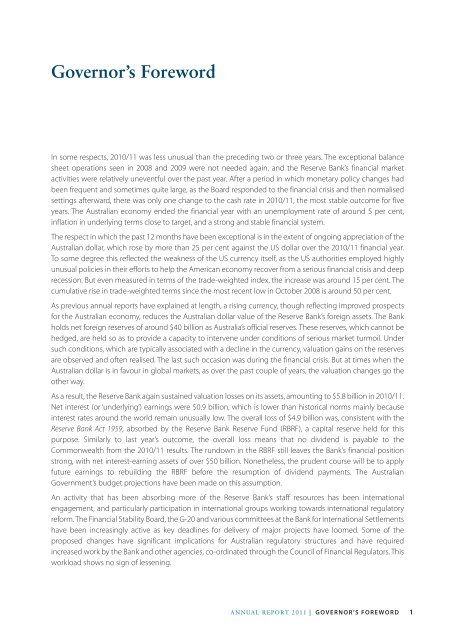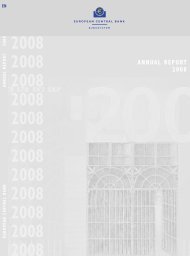Reserve Bank of Australia Annual Report 2011
Reserve Bank of Australia Annual Report 2011
Reserve Bank of Australia Annual Report 2011
Create successful ePaper yourself
Turn your PDF publications into a flip-book with our unique Google optimized e-Paper software.
Governor’s Foreword<br />
In some respects, 2010/11 was less unusual than the preceding two or three years. The exceptional balance<br />
sheet operations seen in 2008 and 2009 were not needed again, and the <strong>Reserve</strong> <strong>Bank</strong>’s financial market<br />
activities were relatively uneventful over the past year. After a period in which monetary policy changes had<br />
been frequent and sometimes quite large, as the Board responded to the financial crisis and then normalised<br />
settings afterward, there was only one change to the cash rate in 2010/11, the most stable outcome for five<br />
years. The <strong>Australia</strong>n economy ended the financial year with an unemployment rate <strong>of</strong> around 5 per cent,<br />
inflation in underlying terms close to target, and a strong and stable financial system.<br />
The respect in which the past 12 months have been exceptional is in the extent <strong>of</strong> ongoing appreciation <strong>of</strong> the<br />
<strong>Australia</strong>n dollar, which rose by more than 25 per cent against the US dollar over the 2010/11 financial year.<br />
To some degree this reflected the weakness <strong>of</strong> the US currency itself, as the US authorities employed highly<br />
unusual policies in their efforts to help the American economy recover from a serious financial crisis and deep<br />
recession. But even measured in terms <strong>of</strong> the trade-weighted index, the increase was around 15 per cent. The<br />
cumulative rise in trade-weighted terms since the most recent low in October 2008 is around 50 per cent.<br />
As previous annual reports have explained at length, a rising currency, though reflecting improved prospects<br />
for the <strong>Australia</strong>n economy, reduces the <strong>Australia</strong>n dollar value <strong>of</strong> the <strong>Reserve</strong> <strong>Bank</strong>’s foreign assets. The <strong>Bank</strong><br />
holds net foreign reserves <strong>of</strong> around $40 billion as <strong>Australia</strong>’s <strong>of</strong>ficial reserves. These reserves, which cannot be<br />
hedged, are held so as to provide a capacity to intervene under conditions <strong>of</strong> serious market turmoil. Under<br />
such conditions, which are typically associated with a decline in the currency, valuation gains on the reserves<br />
are observed and <strong>of</strong>ten realised. The last such occasion was during the financial crisis. But at times when the<br />
<strong>Australia</strong>n dollar is in favour in global markets, as over the past couple <strong>of</strong> years, the valuation changes go the<br />
other way.<br />
As a result, the <strong>Reserve</strong> <strong>Bank</strong> again sustained valuation losses on its assets, amounting to $5.8 billion in 2010/11.<br />
Net interest (or ‘underlying’) earnings were $0.9 billion, which is lower than historical norms mainly because<br />
interest rates around the world remain unusually low. The overall loss <strong>of</strong> $4.9 billion was, consistent with the<br />
<strong>Reserve</strong> <strong>Bank</strong> Act 1959, absorbed by the <strong>Reserve</strong> <strong>Bank</strong> <strong>Reserve</strong> Fund (RBRF), a capital reserve held for this<br />
purpose. Similarly to last year’s outcome, the overall loss means that no dividend is payable to the<br />
Commonwealth from the 2010/11 results. The rundown in the RBRF still leaves the <strong>Bank</strong>’s financial position<br />
strong, with net interest-earning assets <strong>of</strong> over $50 billion. Nonetheless, the prudent course will be to apply<br />
future earnings to rebuilding the RBRF before the resumption <strong>of</strong> dividend payments. The <strong>Australia</strong>n<br />
Government’s budget projections have been made on this assumption.<br />
An activity that has been absorbing more <strong>of</strong> the <strong>Reserve</strong> <strong>Bank</strong>’s staff resources has been international<br />
engagement, and particularly participation in international groups working towards international regulatory<br />
reform. The Financial Stability Board, the G-20 and various committees at the <strong>Bank</strong> for International Settlements<br />
have been increasingly active as key deadlines for delivery <strong>of</strong> major projects have loomed. Some <strong>of</strong> the<br />
proposed changes have significant implications for <strong>Australia</strong>n regulatory structures and have required<br />
increased work by the <strong>Bank</strong> and other agencies, co-ordinated through the Council <strong>of</strong> Financial Regulators. This<br />
workload shows no sign <strong>of</strong> lessening.<br />
ANNUAL REPORT <strong>2011</strong> | GOvernor’s foreword<br />
1





![KNOW YOUR NEW GIBRALTAR BANKNOTES - [Home] bThe/b](https://img.yumpu.com/50890985/1/184x260/know-your-new-gibraltar-banknotes-home-bthe-b.jpg?quality=85)
![PAPUA NEW GUINEA - [Home] - Polymer Bank Notes of the World](https://img.yumpu.com/49758743/1/190x143/papua-new-guinea-home-polymer-bank-notes-of-the-world.jpg?quality=85)










